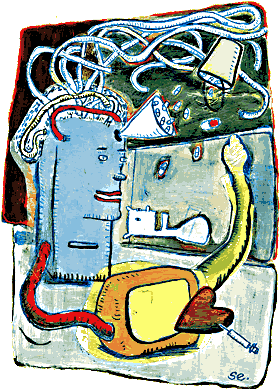
Clearly visible on the screen in the laboratory, a human heart lies beating. The scientist watches closely as, once again, he injects it with another new drug just to see what happens. He makes a few notes before squeezing off the 15th shot of the day.
Inhumane? It would be, if the whole thing weren't a high-res, highly realistic simulation -- and soon to be the world's first complete virtual human.
"We're building models of human cells and organs on a computer platform that are physiologically functional," says Dr. Bill Scott, CEO of Physiome Science in Princeton, New Jersey.
But don't think that the virtual organs are simply scanned in and animated -- they're being "grown" algorithmically. The new flesh takes the functional properties of the original "gene-products," as Scott calls them, and transforms them into active mathematical descriptions. Individual gene-product simulations are combined to form, say, a cardiac cell, which then hooks up with other anatomical elements to build an entire heart.
The beauty of the virtual body systems is that the genetic parameters can be easily altered to simulate a diseased organ. As a result, new drugs may be discovered by targeting individual gene-products to correct the problem. The virtual heart has already been used successfully (in 1997) to test a new cardiovascular drug. Next up for simulation are the lung and bladder. Once the Human Genome Project has decoded the three billion units of DNA present in every human cell, Scott hopes to build a virtual human complete with every known gene-product.
"With that, you could search for drug targets that you'd never have been able to find before," Scott says. "You could do one hundred years worth of experiments in a month using these models."
David Pescovitz is a contributing editor to Wired and co-founder of www.tvultra.com, your daily guide to fringe television.
